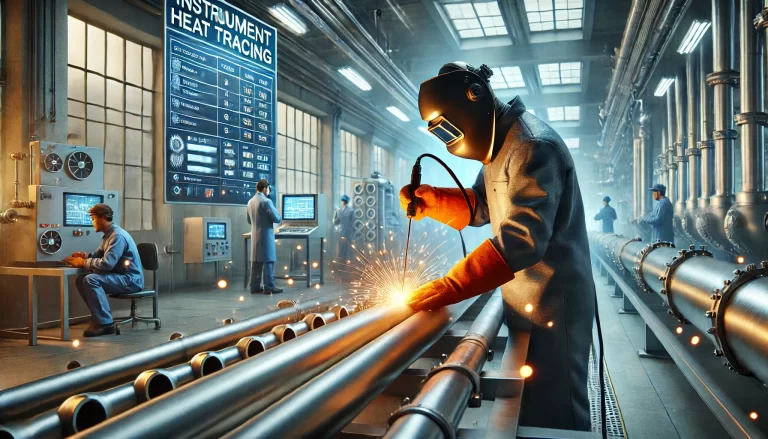Improving the accuracy and reliability of instrument heat tracing pipe welding requires a comprehensive approach that encompasses personnel training, material management, equipment maintenance, welding process control, and quality management. Below is a detailed discussion of the key measures that should be taken to ensure high-quality welding results.
1. Personnel Training and Management
Professional Skills Training
To ensure high-quality welding, personnel should undergo systematic and professional training. The training program should include:
Fundamental Welding Theories: Understanding the principles of welding, heat conduction, and material behavior.
Special Requirements for Instrument Heat Tracing Pipe Welding: Including considerations for temperature control, material compatibility, and corrosion resistance.
Welding Processes for Different Materials: Training welders to handle various pipe materials such as stainless steel, carbon steel, and composite alloys.
Practical Training and Hands-on Experience: Implementing theory lessons alongside real-world welding exercises, case studies, and troubleshooting simulations.
Qualification Certification and Assessment
To maintain welding quality, a rigorous certification and assessment system should be implemented:
Certification Process: Welders should obtain qualifications through formal exams and hands-on performance evaluations.
Regular Assessments: Periodic testing and practical assessments ensure that personnel remain up to date with the latest techniques and industry standards.
Continuous Improvement Programs: Encouraging welders to participate in workshops and refresher courses to enhance their skill sets.
Quality Awareness and Standardized Work Practices
A strong emphasis on quality should be instilled in all welding personnel:
Understanding the Importance of Welding Quality: Conduct regular seminars on the impact of poor welding on instrument performance and safety.
Compliance with Operational Standards: Ensure that welders strictly follow defined welding procedures and industry best practices.
Attention to Detail: Promote a culture where minor defects, such as micro-cracks and porosity, are identified and addressed before final inspection.

2. Material Management
Material Inspection and Quality Control
Ensuring high-quality materials is crucial for achieving reliable welding results:
Verification of Material Specifications: All incoming instrument heat tracing pipes and welding consumables should be thoroughly checked against design specifications.
Detection of Material Defects: Inspect for common defects such as cracks, porosity, inclusions, and uneven surfaces.
Supplier Documentation: Require vendors to provide quality certificates and traceability documents to ensure compliance with relevant industry standards.
Storage and Handling of Welding Materials
Proper storage and handling are essential to maintaining material integrity:
Dedicated Storage Facilities: Establish separate areas for different materials to prevent cross-contamination.
Environmental Controls: Maintain humidity and temperature controls to prevent material degradation, such as rust or oxidation.
Proper Labeling and Organization: Ensure that materials are clearly labeled and organized to avoid confusion and mix-ups during welding operations.
3. Welding Equipment Maintenance
Selection of Suitable Welding Equipment
Choosing the appropriate welding equipment directly affects weld quality:
Matching Equipment to Material and Application: Use TIG welding (GTAW) for stainless steel and MIG/MAG welding for carbon steel applications.
Ensuring Stability and Performance: The welding machine should have stable voltage and current settings to produce consistent results.
Welding Quality Control Features: Equipment should include real-time monitoring features for better process control.
Regular Maintenance and Calibration
Routine maintenance of welding equipment helps prevent defects caused by equipment malfunctions:
Scheduled Cleaning and Inspections: Regularly clean, inspect, and lubricate components to avoid performance issues.
Replacement of Worn Parts: Timely replacement of nozzles, electrodes, and other consumable parts ensures consistent weld quality.
Calibration of Welding Parameters: Regularly calibrate the welding machine to maintain accuracy in welding current, voltage, and gas flow.
4. Welding Process Control
Welding Procedure Qualification
Before actual welding begins, a welding procedure qualification should be conducted:
Testing and Evaluating Welding Parameters: Conduct tests on different welding conditions, including current, voltage, welding speed, and gas flow rate.
Creating a Standardized Welding Procedure: Document the best-performing parameters and establish a welding procedure specification (WPS) for reference.
Approval and Validation: The welding procedure should be reviewed and approved by quality control personnel to ensure compliance with industry regulations.
Developing Detailed Welding Process Documents
Comprehensive process documentation improves efficiency and consistency:
Welding Operating Procedures (WOPs): Provide step-by-step guidelines for each welding operation.
Welding Process Flowcharts: Visual representation of the welding process, including preparation, execution, and inspection.
Quality Control Checklists: Include a list of key inspection points to be verified during and after welding.
Strict Adherence to On-site Welding Standards
Maintaining strict control during actual welding operations ensures consistent quality:
Stable Welding Parameters: Ensure voltage, current, and gas flow rates remain within defined limits.
Control of Welding Speed and Heat Input: Avoid excessive heat input to prevent warping and ensure good penetration.
Inspection During Welding: Conduct real-time monitoring and inspections to detect deviations early.

5. Quality Management and Supervision
Comprehensive Quality Inspection System
A robust inspection system ensures welding quality at every stage:
Pre-welding Inspection: Verify material quality, equipment settings, and pipe preparation.
In-process Inspection: Monitor welding conditions to ensure adherence to WPS.
Post-welding Inspection: Conduct visual inspections, ultrasonic testing (UT), radiographic testing (RT), and penetration testing (PT) to evaluate weld integrity.
Quality Traceability and Feedback Mechanism
Maintaining detailed records of the welding process allows for continuous improvement:
Tracking Weld Details: Record information such as welder identity, welding date, welding parameters, and inspection results.
Identifying and Analyzing Defects: Document any defects found during inspections and determine root causes.
Implementing Corrective Measures: Take proactive actions based on defect analysis to improve future welding processes.
Conclusion
Enhancing the accuracy and reliability of instrument heat tracing pipe welding requires a comprehensive approach that integrates personnel training, material management, equipment maintenance, welding process control, and stringent quality management. By implementing these measures, industries can ensure long-lasting, high-quality welds that improve overall system performance and reliability.
